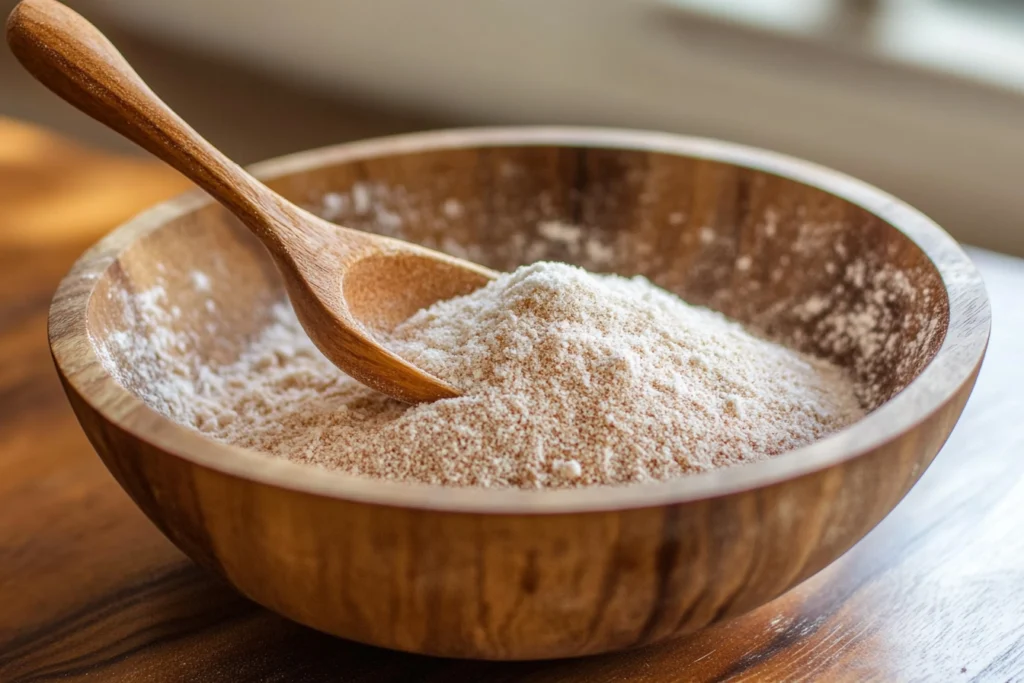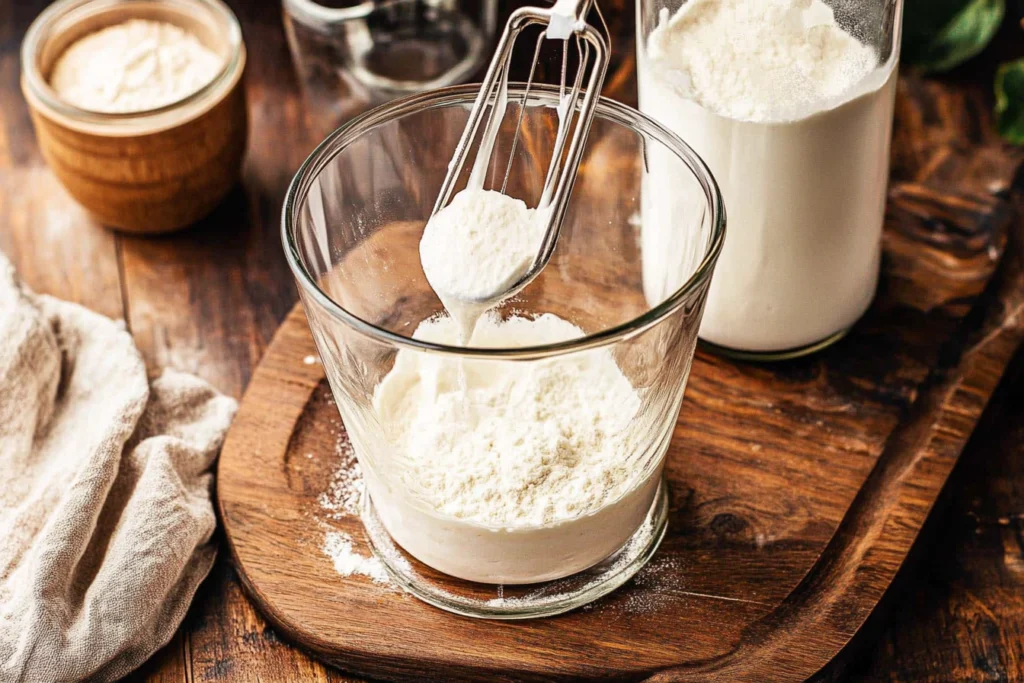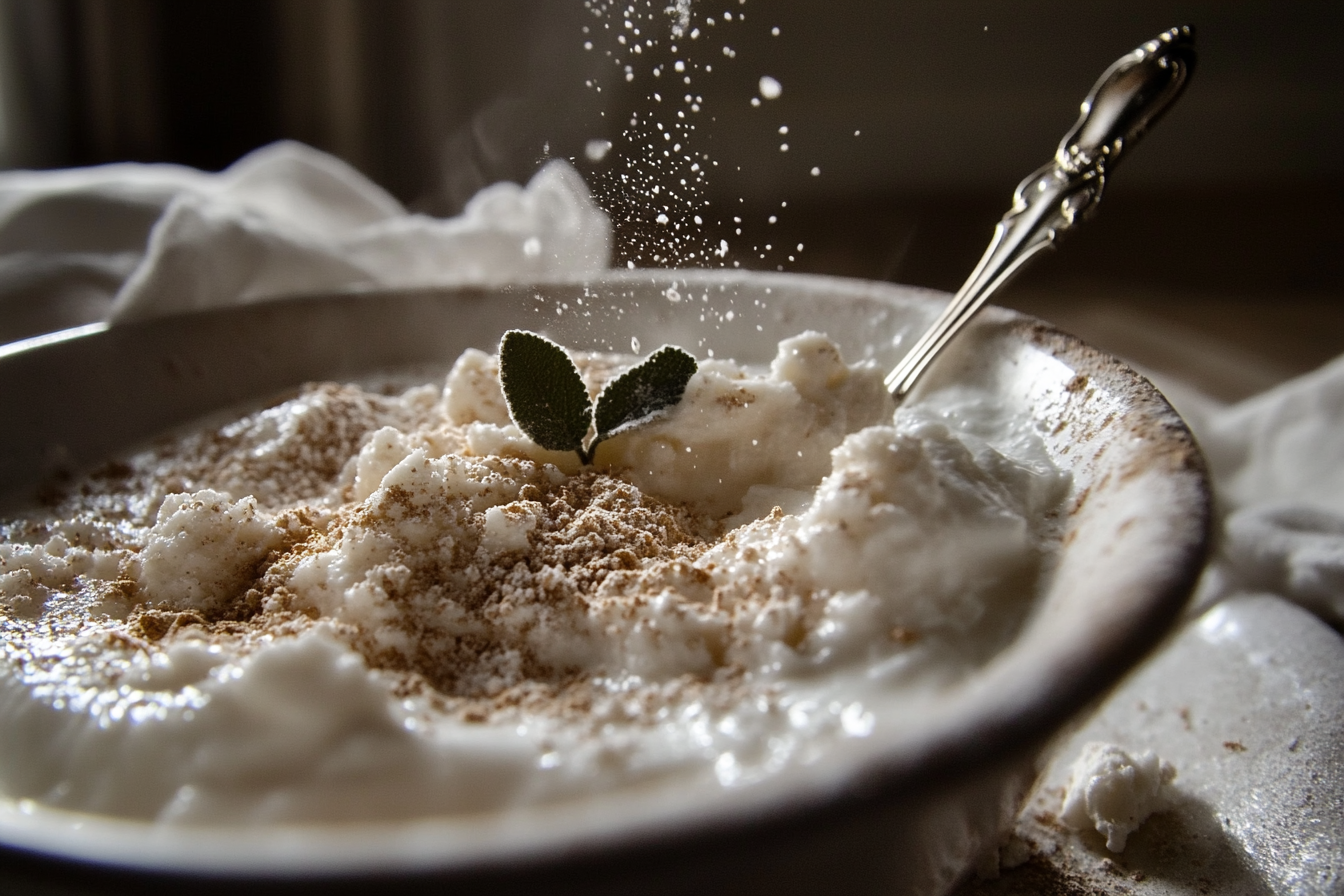H1: The Role of Cream of Tartar in Cookies
H2: What Is Cream of Tartar?
Cream of tartar, also known as potassium bitartrate, is a byproduct of winemaking. It’s a fine, white powder with mildly acidic properties, often used in cooking and baking. Originating from wine barrels where tartaric acid crystallizes, it was first extracted as an easy way to reuse this natural compound.
Its chemical properties make it invaluable in baking. As an acidic agent, it stabilizes ingredients like egg whites and activates baking soda in recipes. This dual functionality is the reason it’s a staple in many cookie recipes.
H2: Primary Functions in Cookie Recipes
- Stabilizing Egg Whites: Cream of tartar plays a vital role in maintaining the structure of whipped egg whites, preventing them from collapsing. This is essential for cookies that rely on airy, meringue-like textures.
- Enhancing Leavening with Baking Soda: As an acid, acidic agent. activates the alkaline baking soda. The chemical reaction releases carbon dioxide gas, which helps the cookie dough rise and results in soft, fluffy cookies.
H2: Common Baking Applications
- Macarons and Meringues: Both recipes depend on stabilized egg whites, making cream of tartar a must-have ingredient.
- Sugar Cookies: The ingredient ensures the cookies are soft, evenly risen, and free of large air pockets.
H1: What Happens Chemically?
H2: Cream of Tartar as an Acidic Agent
When cream of tartar interacts with baking soda, it produces carbon dioxide. This reaction is the backbone of the leavening process in many cookies, as it ensures the dough rises evenly and achieves a light texture. Additionally, it helps balance the pH levels in the dough, which influences flavor and the final product’s structure.
H2: Reaction with Sugars
Cream of tartar prevents sugar from crystallizing, which contributes to smooth textures. In cookies, this property helps maintain a softer, more pliable structure instead of a gritty or brittle one.
H1: Substituting Cream of Tartar
H2: Common Alternatives
- Lemon Juice: Contains citric acid, making it an excellent substitute for replicating the acidic qualities of cream of tartar.
- White Vinegar: Its acetic acid content performs similarly, though it may add a subtle tang to cookies.
H2: When Substitutes Work Well and When They Don’t
Substitutes often work in recipes requiring small amounts of cream of tartar. However, they may not replicate its exact functionality, especially in recipes like meringues, where precise acidity levels are critical for stability.
H1: Historical Context
H2: Cream of Tartar’s Introduction to Baking
The ingredient’s origins trace back to ancient winemaking, where it was discovered as a byproduct. Over time, bakers found its chemical properties ideal for refining baked goods.
H2: How Recipes Evolved with Its Inclusion
The rise of cream of tartar in modern baking marked a shift toward more sophisticated recipes. Cookies became softer and more consistent, paving the way for innovations like sugar cookies and meringues.

H1: Health and Nutritional Insights
H2: Nutritional Benefits of Cream of Tartar
- Rich in Electrolytes: Potassium, an essential electrolyte, is abundant in cream of tartar, offering mild health benefits.
- Low-Calorie Ingredient: A small amount adds functionality without significantly increasing calorie content.
H2: Health Considerations in Baking
While cream of tartar is generally safe for consumption, excessive use could alter the taste of cookies due to its acidity. Some individuals may also opt for substitutes for dietary reasons or availability.
Part 2: Impact of Omitting Cream of Tartar
H1: Effects on Cookie Texture
H2: Loss of Softness
When cream of tartar is omitted from a cookie recipe, one of the most noticeable impacts is on the texture. acidic agent contributes to a softer, more tender bite by preventing sugar from crystallizing and stabilizing the dough structure. Without it, cookies often lose their chewy texture and lean toward a denser, harder consistency.
For example:
- Sugar crystallization can create a grainy feel.
- The dough may spread unevenly, resulting in cookies with a flatter appearance and tougher edges.
H2: Less Fluffiness in Cookies
The leavening process depends heavily on the interaction between baking soda and cream of tartar. Whenacidic agent is omitted, the chemical reaction weakens, reducing the amount of carbon dioxide produced. This directly impacts how much the cookies rise, leading to:
- Less airy textures.
- A denser crumb structure.
- Cookies that lack the characteristic fluffiness often associated with recipes like snickerdoodles or sugar cookies.
H1: Changes in Appearance
H2: Reduced Spread
Cream of tartar influences the spread of cookie dough during baking by affecting the dough’s stability. When left out, cookies may not spread as predictably. The outcome can vary depending on other ingredients:
- If the dough is too dry, the lack of acidic agent results in thick, misshapen cookies.
- For wetter dough, you may observe irregular spreading and uneven edges.
H2: Altered Color
Another subtle yet noticeable impact is on the cookie’s color. Cream of tartar’s acidity affects browning. Without it:
- The cookies may appear darker due to the higher pH level.
- The overall color might be less even, with some areas browning faster than others.
H1: Impact on Flavor
H2: Subtle Changes in Taste
Cream of tartar contributes a faintly acidic tang to cookies. Omitting it can leave cookies tasting slightly sweeter but with a flatter flavor profile. This is especially evident in cookies like snickerdoodles, where the tang complements the sugar and cinnamon.
Key changes include:
- Missing acidic balance, which can make cookies taste overly rich.
- Subtler differentiation between flavor layers in complex recipes.
H2: Effect on Other Ingredients
The absence of cream of tartar can influence how other ingredients behave, particularly sugars and fats:
- Sugar may crystallize more, leading to a gritty texture.
- Fats might not integrate as smoothly, impacting the dough’s consistency and flavor distribution.
H1: Scientific Perspective
H2: Why Cream of Tartar Works in Leavening
The acid-base reaction between cream of tartar and baking soda is crucial for creating carbon dioxide. This process ensures a steady, even rise in cookies. Without this interaction:
- The rise is less pronounced, as the dough lacks sufficient carbon dioxide bubbles.
- The texture becomes denser, as fewer air pockets are formed.
H2: Comparison of Results Without It
Bakers who have experimented with omitting cream of tartar report the following:
- With cream of tartar: Soft, chewy cookies with a balanced rise and tender crumb.
- Without cream of tartar: Dense, flatter cookies with a slightly tougher bite and uneven textures.
H1: When It’s OK to Skip Cream of Tartar
H2: Recipes That Can Adapt Without It
Not all cookie recipes depend heavily on cream of tartar. Some dense or crumbly cookies can still turn out well, even without its inclusion. Examples include:
- Shortbread cookies: Their structure doesn’t rely on leavening agents.
- Biscotti: These intentionally dry cookies do not require softness or significant rise.
H2: Modifications to Compensate
If you must skip cream of tartar but want to preserve texture and flavor, try these adjustments:
- Use an acidic substitute like lemon juice or vinegar.
- Increase the ratio of baking soda slightly for additional leavening.
- Mix in ingredients like yogurt or buttermilk to restore some acidity.
H1: Troubleshooting Common Issues
H2: Flat Cookies
When cookies turn out flat due to the lack of acidic agent, try these fixes:
- Chill the dough before baking to reduce spreading.
- Add an extra egg white to improve structural stability.
- Increase the baking temperature slightly to promote a faster rise.
H2: Grainy Textures
Grainy textures often result from sugar crystallization. To mitigate this:
- Use superfine or powdered sugar for a smoother consistency.
- Add a small amount of honey or corn syrup to prevent crystallization.
Part 3: Practical Baking Insights
H1: Enhancing Recipes Without Cream of Tartar
H2: Combining Baking Powder and Soda
Baking powder can serve as a suitable replacement for cream of tartar in many recipes. It already contains an acidic component, making it a convenient all-in-one leavening agent. If cream of tartar is unavailable:
- Substitute 1 teaspoon of baking powder for every 1/4 teaspoon of baking soda and 1/2 teaspoon of acidic agent.
- Adjust the remaining ingredients to account for the change in acidity.
This substitution ensures cookies maintain a good rise and soft texture.
H2: Using Acidic Ingredients
Adding naturally acidic ingredients can replicate the effects of acidic agent. Popular choices include:
- Buttermilk: Its tangy flavor complements many cookie recipes while adding moisture and acidity.
- Greek Yogurt: Offers similar benefits but with a creamier texture.
When using these substitutes, reduce other liquids in the recipe to maintain the correct dough consistency.
H1: How Bakers Test for Substitutes
H2: Experimental Baking Tips
Baking without cream of tartar often requires experimentation. To ensure consistent results, follow these tips:
- Side-by-Side Comparisons: Bake two batches—one with acidic agent and one with a substitute—to observe differences in texture, flavor, and appearance.
- Controlled Conditions: Measure ingredients precisely and bake in a temperature-controlled oven to minimize variables.
- Record Observations: Note the outcomes for each substitution, such as rise, spread, and flavor changes.
H2: Recording Results and Preferences
Bakers should document their experiments to refine future recipes. Key details to record include:
- Ingredient ratios and substitutions.
- Changes in dough behavior during mixing and baking.
- Final cookie characteristics like texture, taste, and color.
H1: Baking for Dietary Restrictions
H2: When Cream of Tartar Isn’t Available
Home bakers in remote areas or those with dietary restrictions may not always have access to cream of tartar. To improvise:
- Use lemon juice or vinegar for recipes that need acidity.
- Incorporate baking powder as a standalone leavening agent.
These adjustments ensure cookies remain enjoyable without specialized ingredients.
H2: Adapting Recipes for Taste and Texture
When replacing cream of tartar, balancing flavors and maintaining texture is crucial. Strategies include:
- Adding a pinch of salt to offset sweetness if acidity is reduced.
- Using molasses or brown sugar to add moisture and richness.
H1: Ingredient Synergy in Cookies
H2: Role of Other Leavening Agents
In recipes without cream of tartar, other leavening agents play a more prominent role. Baking soda and baking powder can be adjusted to achieve desired results:
- Baking soda alone needs an acid to activate, making substitutes like vinegar essential.
- Baking powder can replace both soda and acidic agent for simpler adjustments.
H2: Balance of Flavors
Maintaining flavor harmony is key when substituting ingredients. Tips for balance include:
- Adjusting sweetness to account for missing acidity.
- Adding vanilla or almond extract to enhance overall flavor complexity.
H1: Educating Home Bakers
H2: Resources for Learning
Home bakers looking to expand their skills can turn to various resources:
- Online Guides: Blogs and videos offer step-by-step instructions for adapting recipes.
- Community Baking Forums: Platforms like Reddit and Facebook groups provide valuable tips from experienced bakers.
H2: Building Confidence in Substitution
Substituting cream of tartar can feel intimidating, but with practice, bakers gain confidence. Start with simple recipes like sugar cookies before experimenting with more complex options like macarons.
H1: Recipe Examples
H2: Modified Sugar Cookie Recipes
Here’s a simple sugar cookie recipe without cream of tartar:
Ingredients:
- 1 cup unsalted butter
- 1 cup granulated sugar
- 2 large eggs
- 2 3/4 cups all-purpose flour
- 1 teaspoon baking powder
- 1/2 teaspoon baking soda
- 1 tablespoon lemon juice
Instructions:
- Cream the butter and sugar together until fluffy.
- Add eggs and lemon juice, mixing well.
- Combine dry ingredients in a separate bowl and gradually incorporate into the wet mixture.
- Chill the dough for 30 minutes, then bake at 350°F (175°C) for 10-12 minutes.
H2: Alternative Cookie Styles
For denser, crumbly cookies, skip leavening agents altogether. Recipes like shortbread or biscotti offer rich textures and flavors without the need for cream of tartar.

H1: Long-Term Impacts on Baking
H2: Evolving Cookie Recipes Without Cream of Tartar
As baking techniques continue to evolve, the reliance on cream of tartar in cookie recipes is gradually diminishing. With the growing availability of versatile substitutes, bakers have embraced innovative approaches to achieve the same textures and flavors without compromising on quality. These innovations include:
- New Leavening Blends: Custom combinations of baking soda and acidic components (like buttermilk or lemon juice) are now tailored for specific recipes, offering better control over rise and texture.
- Acidity Adjustments with Natural Ingredients: Ingredients such as yogurt, vinegar, and fruit juices are being incorporated to replicate the tang and stability cream of tartar provides. These substitutions align well with trends toward natural and less processed ingredients.
This shift not only modernizes traditional recipes but also makes them more adaptable to ingredient availability and dietary needs.
H2: Future Trends in Baking Ingredients
Looking ahead, the world of baking is poised to embrace an era of increased creativity and flexibility. As the culinary landscape shifts, expect trends such as:
- More Plant-Based and Natural Leavening Agents: With the rise of plant-based diets and sustainable baking practices, there’s a push for natural alternatives to traditional ingredients. These include vinegar from fruits, fermented liquids, or innovative plant-derived acids.
- Recipes Emphasizing Ingredient Flexibility: To accommodate dietary preferences, bakers are designing recipes with a focus on customization. For example, cookies that work well with multiple types of leavening agents, enabling bakers to substitute ingredients like cream of tartar without compromising results.
More FAQs
1. Can I skip cream of tartar in all cookie recipes? No, certain recipes like macarons or snickerdoodles heavily rely on it. For others, substitutions work well.
2. What is the best cream of tartar substitute for cookies? Baking powder or lemon juice are ideal substitutes, depending on the recipe.
3. How does cream of tartar affect cookie flavor? It adds a subtle tang and balances sweetness.
4. What happens if I don’t use cream of tartar? Cookies may be denser, less fluffy, and have a grittier texture.
5. Can I use yogurt instead of acidic agent? Yes, but adjust other liquids in the recipe to maintain consistency.
6. Does cream of tartar expire? Yes, its potency decreases over time. Store it in a cool, dry place.
7. Are there health benefits to using baking acid,? It’s low-calorie and provides potassium, but its impact is minimal in small amounts.
8. Can I make meringues without baking acid,? Yes, but substitutes like lemon juice or vinegar are necessary for stability.
9. What’s the difference between baking powder and cream of tartar? Baking powder is a combination of an acid and a base, while acidic agent is solely an acid.
10. Is cream of tartar gluten-free? Yes, it’s naturally gluten-free.
Related Article : Why is cream of tartar needed in snickerdoodles?

